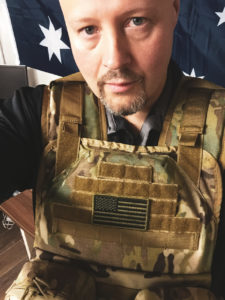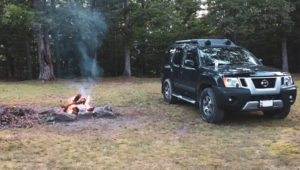BLOG / Behind the Scenes
BTS Behind the Scenes: Meet Jesse Scites, Lead Engineer
BTS Behind the Scenes is a chance to showcase the people who are making things happen behind the scenes at BTS so our teams can do their best work on the front lines. In today’s feature you’ll get to know Lead Engineer Jesse Scites and hear about the impact of miniaturization in RF, the need to be well-rounded as an EE, and just how powerful a Dixie Chopper Zero Turn can be.
 Tell us How You Got to BTS
Tell us How You Got to BTS
After my time in the Army I attended engineering school for Electrical Engineering. During my senior year I was approached by several defense contractor companies and by the time I graduated, I decided to go straight back into the defense world. I worked for Raytheon for 12 years on SIGINT contracts but eventually found that the big corporate environment just wasn’t a good fit for me anymore. I then went to Penn State Applied Research Lab doing more defense contract work, and after leaving there, I got linked up with Tom Bohne via a mutual friend. At BTS I’ve been able to get back to my roots doing electronics, RF and signals analysis, along with the reverse engineering of commercial based technologies (CBT) to support our customer counter RCIED/IED and counter UAS mission set since 2013.
How Have You Seen Your Space Change Over the Years?
In terms of the working environment I’ve seen everything expand. Teams are bigger. For example, when I started working with the customer our division had less than 100 personnel; we now have over 300. A lot of that growth is due to the expansion of the counter UAS mission. As far as technology, the biggest difference between 10-15 years ago and now is the proliferation and cheap access to complete radio architectures on a single integrated circuit (IC) chip. The capabilities of RF communication devices that used to be 6 to 12 square inches are now available on programmable IC’s smaller than a thumbnail.
It’s good for consumers because it’s cheap and small and it’s getting produced at mass scale, yet it’s made counter RCIED/UAS even harder. Many of the IC chips are programmable within defined frequency and encoding options with multiple modulation techniques to choose from. And most of them are less than $8. This miniaturization has also led to huge advances in UAS development and form factors; especially with the advances in CPU/MCU, memory and sensor technology. Access to CBT by the masses, including hobbyists and bad actors alike, becomes easier and cheaper as miniaturization and low-cost mass production increases.
What Keeps You Coming Back Each Day?
Supporting the military and other stakeholder organizations against threats. I’ve always done defense work, it’s what I like to do, and it has always given me a purpose. It’s a reason to get up in the morning.
What’s a Completely Different Career Path You Could See Yourself in?
Maybe a boat captain doing private charter. Maybe the manager of a remote inn in the middle of Switzerland in the middle of nowhere.
Favorite Movie on a day off?
Big Trouble in Little China. It’s a cult movie but I like it.
What Advice do you Have for Recent Graduates in Engineering Fields?
Never stop learning if you are doing anything related to C-RCIED/C-IED/CUAS. Technology is evolving in a non-linear way and it’s accelerating. Regardless of your engineering discipline, once you know the basics, try to keep up on the CBT advances and how they relate to practical consumer applications. Those are things that get exploited by bad guys who are purchasing commercially based tech and then adapting it. Second, know how to use online resources in a practical way. Know how to separate fact from fiction. Take things with a grain of salt and filter what you’re seeing. Don’t let a single source be the only place you acquire knowledge. Supplement what you know with multiple sources. Pursue practical experience, utilize your technical peers, and always try to open dialogues with people that are doing what you’re interested in.
What’s Got You Excited About Future/Emerging Tech?
As far as what’s out there right now, the radio architecture miniaturization on an extremely tiny IC chip is significant. They are semi-programmable (not software defined) and have huge amounts of frequency and data encoding diversity. And they’re so cheap. For a few dollars and some basic programming skill, it provides the user with a lot of flexibility.
In the near future, the advancements in RF signals that are more and more resistant to jamming is exciting. There are also advancements being made in integrated UAS, AI, swarming technology, etc. Most of that isn’t yet realized but we’re seeing more and more future advancements in drones working together. That’s in the near future but it’s not really here yet. In UAS (Unmanned Aerial Systems), a primary focus will always be on smaller IC chips and boards that fit into smaller form factors with less platform weight. Take DJI for example. All of that miniaturization allows a huge amount of CBT to fit into a small, integrated platform. Tracking the evolution of electronic systems that can be developed on a single IC, be it for RF communications or otherwise, is exciting.
 What Are You Doing When You’re Not at Work?
What Are You Doing When You’re Not at Work?
Eventually I plan to build an electronics lab in my basement because I like tinkering with electronics and amateur radio. What I mainly do now is a lot of yard work. Mowing, weed-eating, planting trees, things like that. I have about 8 fruit trees and a 20 x 30 fenced off garden (when I’m home long enough to raise anything).
Word on the Street is that You Have a Pretty Incredible Lawnmower?
It’s a Dixie Chopper Magnum Series zero turn lawnmower. Lots of horsepower, twin 5-gallon tanks. It’s just a big and strong lawnmower. It’s pretty fast.
Any Other Words of Wisdom to Share?
I’ve had a slow progression toward working for smaller and leaner companies like BTS. I like that BTS is small and we’ve got the back-end support we need without being big and bloated. That, to me, creates the ideal situation where you can work directly with the customer and have that flexibility and low overhead, etc. Companies need to be agile and flexible and BTS meets that demand, not just for defense work but for commercial as well. You need the big companies for the really big programs, but there’s something to be said for organizations of less than 100 people where you have the flexibility and professional freedom to provide the best possible support to your customer.
Tags: bts, jesse scites, staff
Contact BTS to explore solutions for your intelligence or defense challenges.